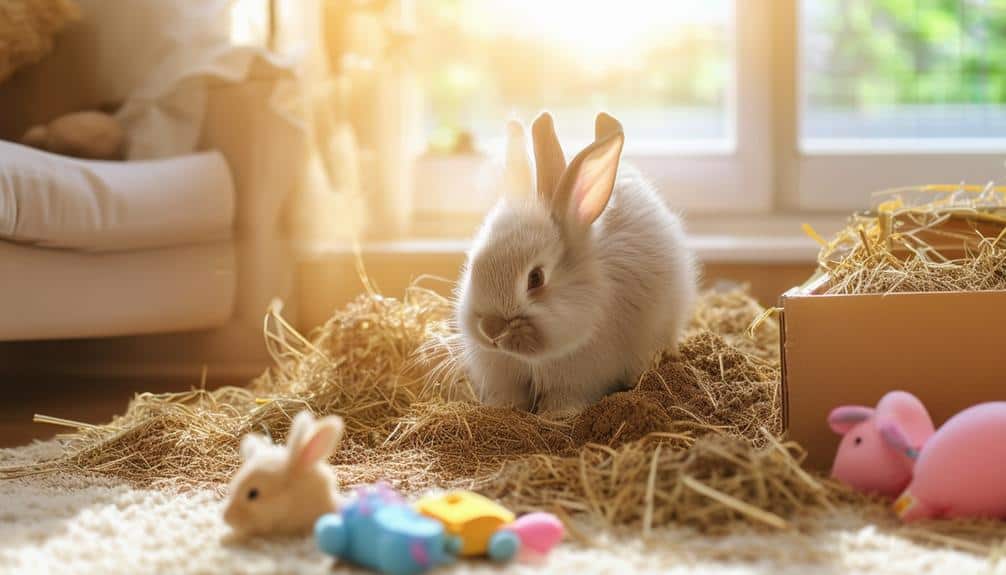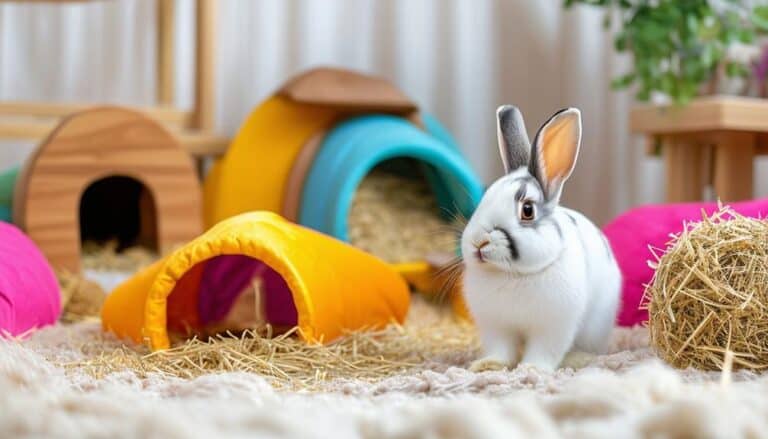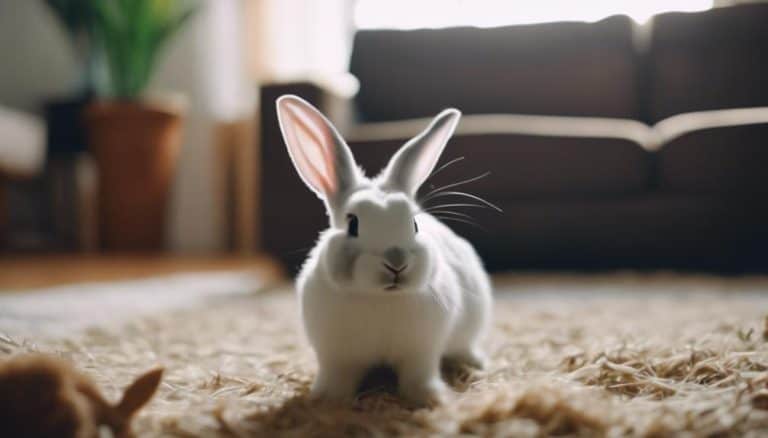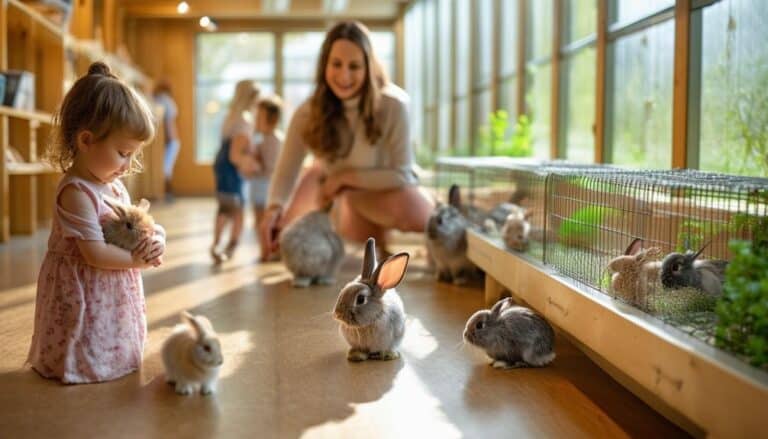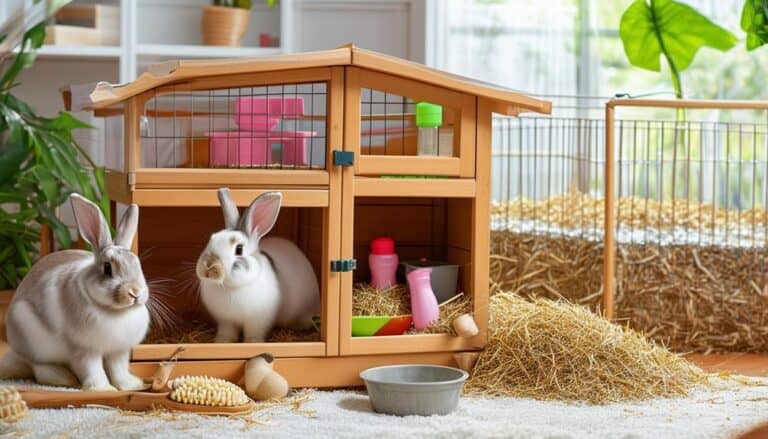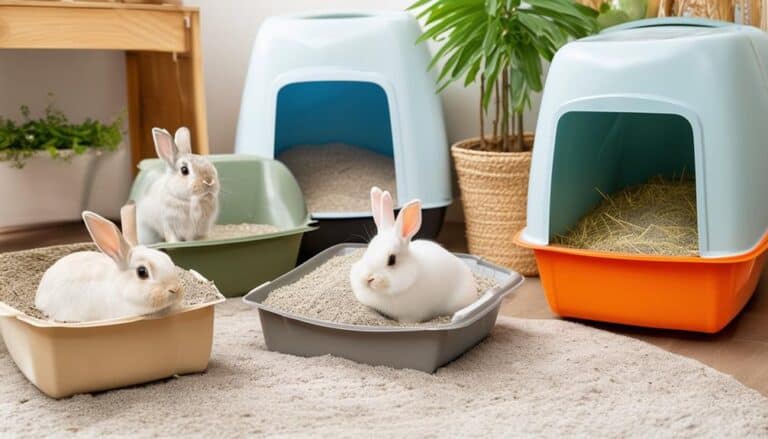What Is a Pet Rabbit Digging Box?
A pet rabbit digging box provides a controlled environment where rabbits can express their natural digging behaviors safely. We fill these boxes with non-toxic materials like shredded paper, hay, or soil, promoting mental stimulation and physical exercise. Proper box selection focuses on size, durability, and safety to prevent ingestion of harmful substances.
Regular monitoring and maintenance guarantee a hygienic and engaging outlet for rabbits, reducing destructive tendencies. Incorporating treats and toys can further stimulate their foraging instincts. To explore how to optimize your rabbit’s digging box setup and maintenance, continue engaging with our detailed insights.
Understanding Rabbit Digging Behavior
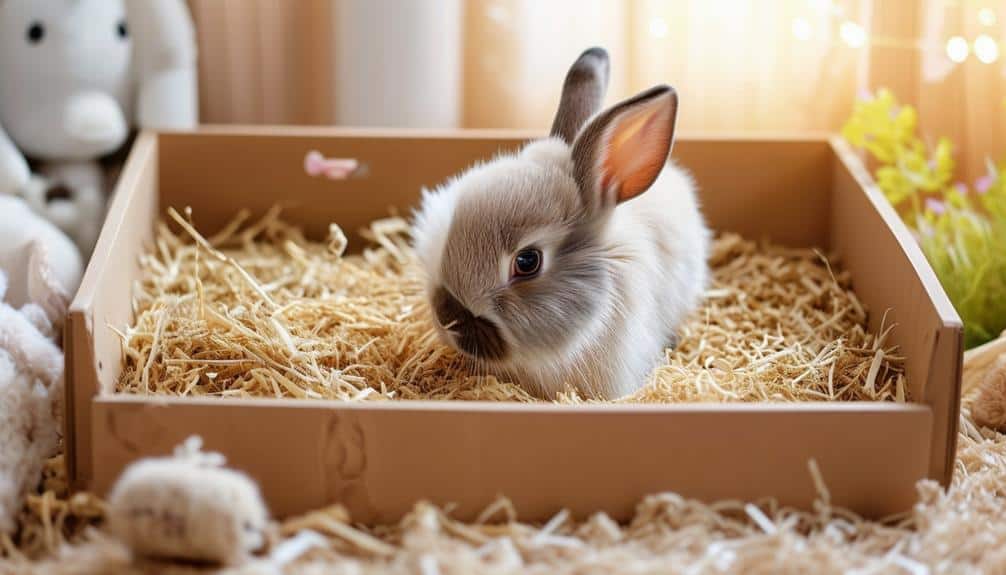
Understanding rabbit digging behavior is pivotal for ensuring their overall health and well-being. Rabbits instinctively dig to construct burrows, uncover food, escape predators, expose cooler earth, or seek attention. This behavior isn’t merely recreational but is deeply ingrained in their biology. Female rabbits, for instance, tend to create more extensive burrows, whereas males often make scrapes to mark their territory.
We must recognize that digging is essential for muscle use and meeting their welfare needs. Providing appropriate outlets for these digging behaviors is vital. Without suitable options, rabbits may exhibit stress or engage in destructive behaviors, like digging up carpets or gnawing on furniture.
Rabbit toys specifically designed for digging, such as tunnels and soft digging mats, can offer excellent alternatives. These toys not only satisfy their natural urges but also contribute to their physical and mental well-being.
Incorporating rabbit toys that cater to their digging instincts ensures that they remain engaged and active. Properly managed digging behavior is integral to maintaining a rabbit’s health, fostering an environment where they can thrive. It’s our responsibility to facilitate opportunities for them to express these natural behaviors safely and effectively.
Benefits of a Digging Box
A digging box serves as an essential tool for channeling a rabbit’s natural instincts into a safe, controlled environment. By providing a rabbit digging box, we cater to the species-specific behavior of digging, which is deeply rooted in their natural behavior. This controlled outlet prevents our pets from engaging in destructive digging in inappropriate areas, such as carpets or furniture.
Moreover, the rabbit digging box promotes mental stimulation and physical exercise, two critical components of a rabbit’s overall well-being. When rabbits are given the opportunity to dig, they engage in an enriching activity that mirrors their natural habitat. This not only keeps them entertained but also reduces stress and prevents boredom, which are common issues in domestic settings.
Furthermore, the designated digging area enhances a rabbit’s happiness and contentment. By encouraging this natural behavior in a safe space, we help maintain their mental and emotional health. The physical exertion involved in digging also contributes to their fitness, thereby promoting a healthier lifestyle.
In essence, a rabbit digging box is indispensable for fulfilling a rabbit’s instinctual needs, ensuring they remain happy, healthy, and fully engaged in their environment.
Choosing the Right Box
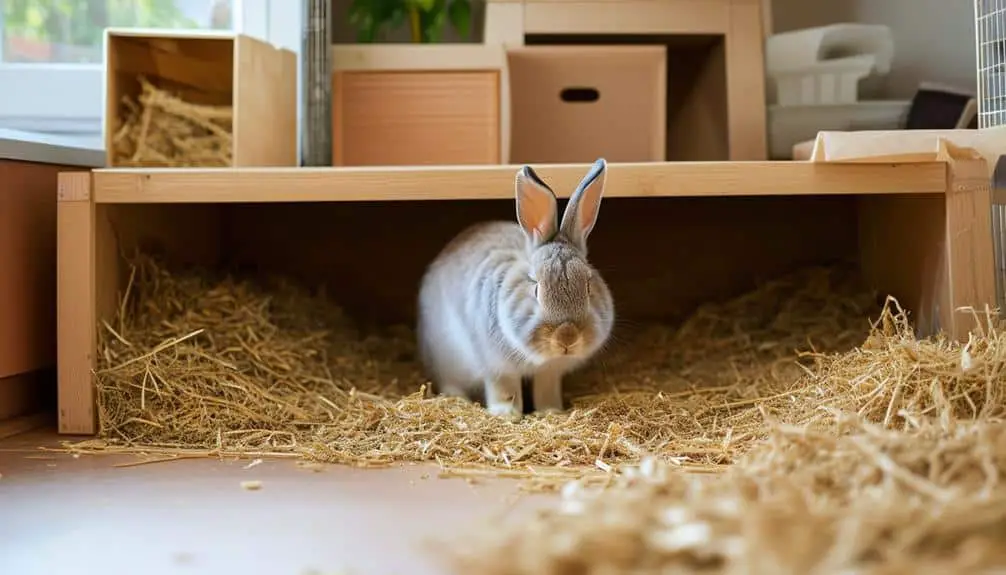
When selecting the right digging box for our rabbits, we must prioritize both the size and material to guarantee safety and comfort.
It’s crucial to choose materials like cardboard, plastic, or untreated wood that are safe if ingested, particularly for rabbits prone to chewing.
Moreover, the box should be spacious enough to allow free movement and effectively contain the chosen digging medium.
Size and Material
Selecting the suitable size and material for a rabbit digging box is vital to ensuring the animal’s safety and comfort. A well-proportioned digging box should measure at least 2 feet long by 1 foot wide and 6 inches high. This size provides ample space for our rabbits to engage in their natural digging behaviors while moving comfortably within the box.
When considering the material for the digging box, we’ve several options, including cardboard, plastic, wicker, metal, and wood. Each material has its own advantages and considerations. Cardboard is lightweight and easy to replace, but it may not be durable for vigorous diggers. Plastic is durable and easy to clean but should be non-toxic. Wicker offers a natural look but mightn’t withstand heavy use. Metal is sturdy but can be less comfortable. Wood is robust but should be untreated to avoid harmful chemicals.
For rabbits prone to chewing, we recommend using paper filler or organic, untreated topsoil in the digging box. These materials are safer alternatives to sand or soil. Ensuring the box contains the digging material securely is essential for maintaining a clean and enriching environment. Proper maintenance and cleaning will further enhance this essential habitat feature.
Safety Considerations
Ensuring the safety of our rabbits while they dig requires careful examination of the materials and construction of their digging boxes. We need to guarantee that the chosen box prevents any harm to our furry companions. Let’s explore the key aspects to take into account:
| Material | Safety Features | Durability |
|---|---|---|
| Untreated Wood | Non-toxic, smooth edges | Sturdy, long-lasting |
| Plastic | No sharp edges, stable | Durable, easy to clean |
| Cardboard Box | Non-toxic, safe to chew | Lightweight, replaceable |
First, opting for safe materials like untreated wood, plastic, or a cardboard box is essential. Untreated wood and cardboard are generally non-toxic, ensuring that if our rabbits chew on them, they won’t ingest harmful substances. Plastic should be free from sharp edges and made stable to prevent accidents.
Next, we must make sure the box is sturdy and stable. A box that collapses or tips over can cause injury, making it essential to choose a design that withstands vigorous digging. Additionally, we should avoid boxes with toxic materials or small parts that could be ingested.
Lastly, consider the dimensions and weight. The box should be large enough to allow comfortable movement and vigorous digging, yet durable enough to prevent easy tipping or damage. By following these guidelines, we can create a safe and enjoyable digging environment for our rabbits.
Best Digging Materials
Let’s consider the best materials for our rabbit’s digging box, focusing on safe substrates and natural foraging options.
Shredded paper, hay, and soil offer both safety and enrichment, creating an ideal environment for digging.
Safe Digging Substrates
Choosing the safest and most stimulating digging substrates for our pet rabbits is vital to cater to their natural instincts and safeguard their well-being. Selecting the right digging material not only guarantees their safety but also enhances their mental and physical health. The substrates we choose must be non-toxic and appropriate for each rabbit’s individual tendencies.
Crumbly soil and children’s play sand are excellent options for rabbits that don’t ingest foreign objects. These materials mimic the natural environment, providing an engaging and safe digging experience. For rabbits prone to chewing, paper fillers such as shredded paper are ideal. They are safe if ingested and still offer a satisfying digging experience.
Here’s a breakdown of some recommended safe digging substrates:
| Digging Material | Characteristics | Suitability |
|---|---|---|
| Crumbly Soil | Natural, easy to dig | Ideal for non-chewers |
| Play Sand | Mimics natural habitat | Suitable for non-ingesters |
| Shredded Paper | Non-toxic, safe if chewed | Best for chewers |
Providing these appropriate substrates in the digging box allows our rabbits to engage in their natural behaviors, promoting their overall well-being and happiness. Ensuring we use safe and stimulating materials is essential for their health and enrichment.
Natural Foraging Options
Incorporating natural foraging options like shredded paper, hay, soil, and safe tunnels into a rabbit’s digging box not only satisfies their instinctual behaviors but also promotes their mental and physical well-being. By providing a variety of substrates, we can simulate the diverse textures and environments rabbits would encounter in the wild.
Shredded paper, for instance, is an excellent material for rabbit digging as it mimics the loose, pliable nature of earth while being safe and non-toxic. Hay, another superb option, serves a dual purpose: it’s both a foraging material and a dietary necessity. Rabbits can burrow through it and nibble on it, fulfilling their need to dig and their nutritional requirements simultaneously.
Adding soil to the mix offers a completely different sensory experience, engaging their sense of smell and touch with a more authentic digging medium. Furthermore, safe tunnels and hiding spots within the digging box introduce an element of exploration and excitement. These structures not only enrich the environment but also encourage natural behaviors like burrowing and hiding.
DIY Digging Box Guide
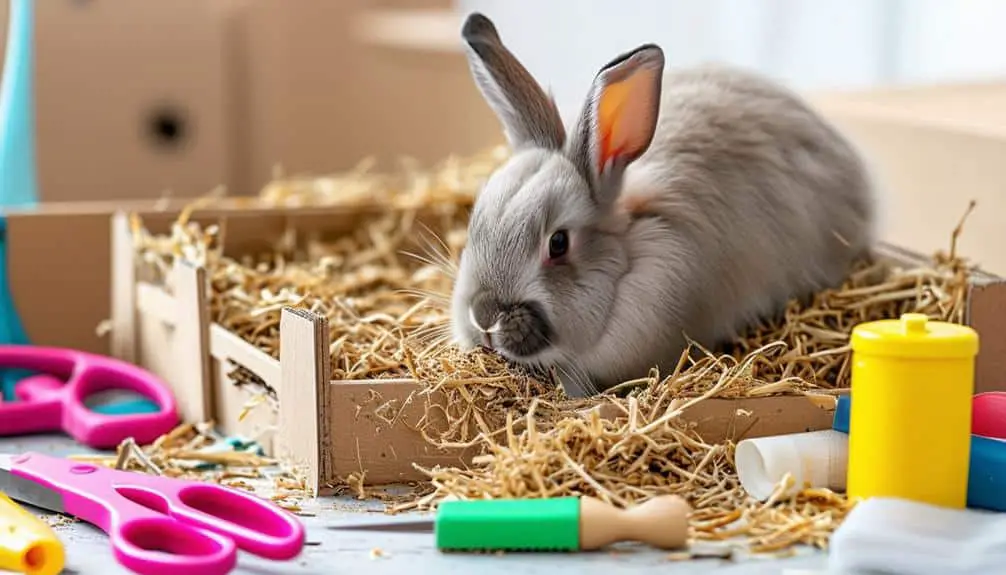
Creating a DIY digging box for your rabbit involves selecting appropriate materials and filling them with stimulating elements that cater to your pet’s natural behaviors. To start, we can use various containers such as cardboard boxes, plastic bins, or wicker baskets. These materials are readily available and can accommodate the typical rabbit digging activities.
For filling, options like shredded paper, hay, dirt, or even snow provide diverse textures that engage a rabbit’s instinct to dig and forage.
When choosing materials, it’s important to take into account their safety and suitability. For instance, a paper litter box filled with shredded paper or hay can mimic natural foraging environments, encouraging healthy exploratory behavior. However, we should closely monitor our rabbits to make sure they don’t ingest excessive cardboard or paper, which could lead to digestive issues.
To further enhance the digging box, we can hide treats such as pellets, hay treats, dried herbs, or dried fruits within the filling. This not only incentivizes exploration but also stimulates mental engagement.
Safe Digging Practices
To ensure our rabbit’s well-being, we must use safe materials like shredded paper, hay, or organic soil in the digging box. These materials not only provide a natural and stimulating environment but also minimize the risk of ingestion of harmful substances. When we make a digging box, utilizing rabbit hay is particularly beneficial given its dual purpose of acting as both bedding and a nutritional supplement.
Ensuring the containment of the digging box is essential. We need to prevent spills that could lead to unsanitary conditions or potential hazards. A securely contained box also mitigates the risk of our rabbits ingesting materials that could be harmful. Regular supervision while our rabbits use the digging box is important. This allows us to intervene if any unsafe behavior occurs and also provides the opportunity to reinforce positive digging behaviors.
Maintaining cleanliness is another cornerstone of safe digging practices. Regular cleaning and replacement of materials in the digging box help sustain a hygienic environment, reducing the risk of infections or illnesses. We should encourage positive behaviors by rewarding our rabbits with treats or toys when they appropriately use the digging box. This not only enhances their experience but also promotes physical and mental well-being.
Placement of the Digging Box
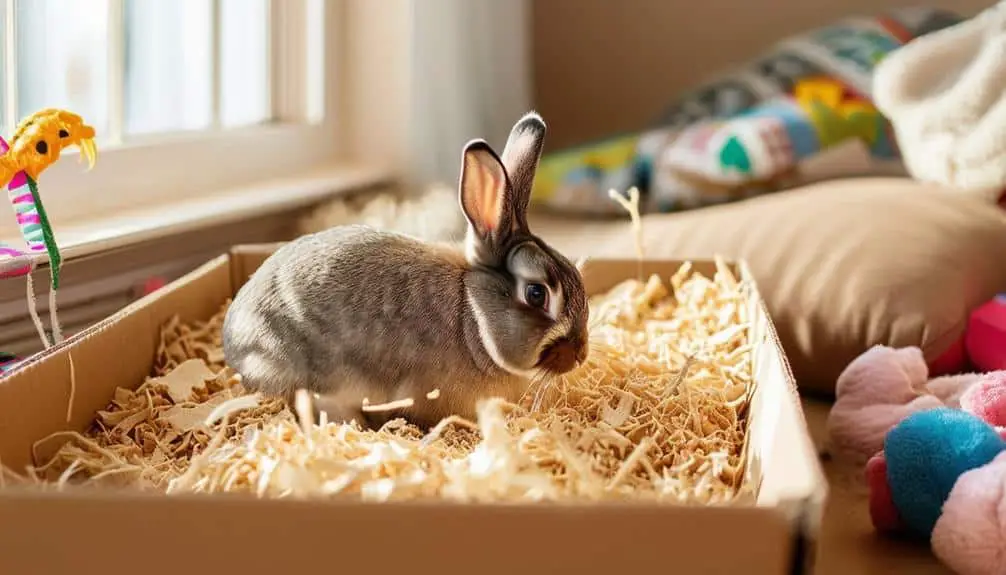
Ensuring important placement of the digging box is essential for maximizing its use and maintaining the rabbit’s sense of security. To achieve this, we should position the rabbit digging box in a corner or against a wall. This provides a stable, enclosed environment that mirrors the rabbit’s natural burrowing instincts.
Placing the box behind furniture or underneath a table can further create a cozy, secluded digging spot. Rabbits often seek out these areas for comfort and safety, making them ideal locations. Additionally, monitoring our rabbit’s behavior can provide invaluable insights.
If a rabbit already shows interest in digging in a particular spot, it’s prudent to place the box there to encourage its use. Accessibility is another important factor in the placement of the digging box. While it should be easy for the rabbit to access, it shouldn’t be in a high-traffic area to avoid disturbances that could deter the rabbit from using it.
Adding Treats and Toys
Incorporating treats and toys into a rabbit’s digging box greatly enhances its enrichment value and promotes natural foraging behaviors. By carefully ensuring that various treats such as pellets, hay treats, dried herbs, and dried fruit are hidden within the digging substrate, we can stimulate our rabbits’ innate foraging instincts. This not only provides mental stimulation but also keeps them physically active as they dig and search for these hidden treasures.
Adding toys further enriches the environment, turning the digging box into a multifaceted playground. Items such as tunnels, hiding spots, and chew toys can cater to a rabbit’s curiosity and encourage exploratory behavior. These elements foster an engaging and dynamic space, which can alleviate boredom and reduce the likelihood of destructive behaviors.
It’s crucial to double-check that all treats and toys included in the digging box are safe and appropriate for rabbits. By combining treats and toys, we create a rewarding and stimulating experience, one that keeps our rabbits engaged for extended periods.
This proactive approach to enrichment offers our rabbits the freedom to express their natural behaviors in a controlled and beneficial manner, ultimately contributing to their overall well-being and happiness.
Maintaining the Digging Box
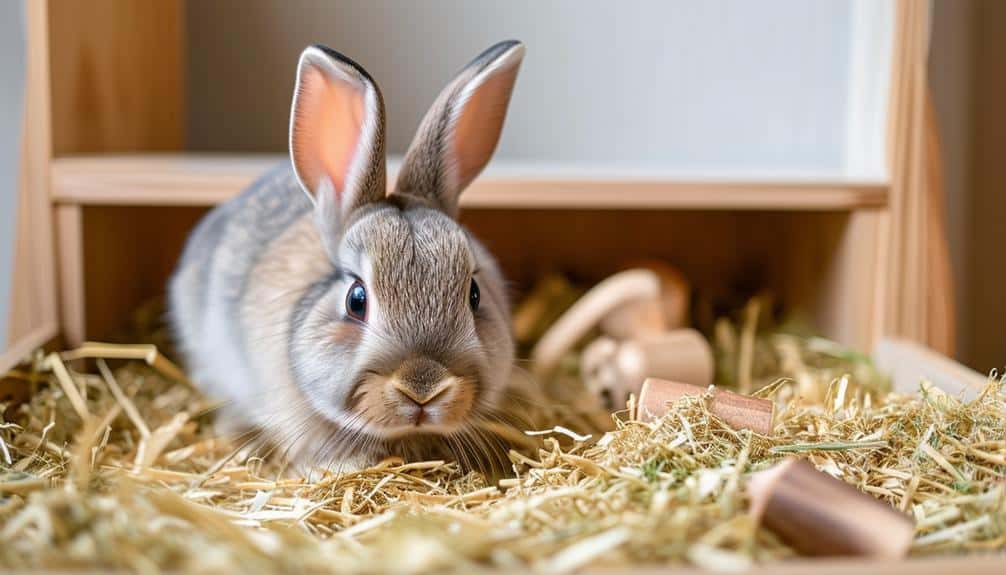
To guarantee our rabbit’s digging box remains an inviting and hygienic space, we must establish a regular cleaning routine.
We’ll also need to consistently refill the digging material to maintain their interest and inspect the box for any signs of wear.
These practices will help promote a healthy and stimulating environment for our pet.
Regular Cleaning Routine
Regularly cleaning the digging box is essential for providing a hygienic and comfortable environment for your rabbit. To establish an effective cleaning routine, we must first recognize the importance of frequent maintenance. A clean digging box promotes not only the health of our rabbits but also their overall well-being and comfort.
To begin, it’s vital to use a fine litter scoop to meticulously remove any soiled or wet material from the digging box. This practice prevents odor buildup and maintains the freshness of the digging area. By removing contaminants promptly, we guarantee that our rabbits have a clean space to engage in their natural digging behavior.
Maintaining the area around the digging box is equally important. We should keep this vicinity easy to clean, facilitating quick and efficient maintenance. Regularly attending to this space minimizes the spread of debris and maintains a tidy environment.
Refill Digging Material
Maintaining the digging material fresh and stimulating is crucial for creating an engaging and hygienic environment in the rabbit’s digging box. Regularly replacing the digging material not only preserves cleanliness but also keeps our rabbits mentally and physically stimulated. We must observe our rabbit’s preferences and behavior to determine the best frequency for replacing the digging material. For instance, a rabbit that digs enthusiastically and frequently will require more frequent refills compared to a less active one.
Adjusting the frequency of refilling the digging material ensures that our rabbits enjoy a continuously enriching experience. A clean and comfortable digging box greatly contributes to their overall well-being and enrichment. Here’s a quick guide to help determine when to replace the digging material:
| Frequency of Digging | Recommended Replacement Schedule |
|---|---|
| High | Every 3-4 days |
| Moderate | Weekly |
| Low | Bi-weekly |
Ensuring the digging box is easy to clean is another critical aspect of maintaining hygiene. A straightforward cleaning process facilitates regular replacement of the digging material, ensuring our rabbits always have a pristine and stimulating environment. By keeping the digging material fresh and engaging, we enhance our rabbits’ freedom to explore and enjoy their natural behaviors.
Inspect for Wear
In addition to guaranteeing the refilling of the digging material, we must carefully inspect the digging box for any signs of wear and tear to secure our rabbit’s safety and comfort. Regular inspection is crucial to maintaining a secure and enjoyable environment for our furry friend. We should consistently check the box for potential hazards that could cause injury or distress.
Key aspects to inspect include:
- Sharp Edges: Confirm there are no sharp or jagged edges that could harm your rabbit while they dig.
- Loose Parts: Verify that all parts are securely fastened to prevent any accidental disassembly.
- Damage: Look for any holes, cracks, or weak spots that might require reinforcement or repair.
Troubleshooting Common Issues
One common issue with rabbit digging boxes is a lack of interest, which can often be resolved by incorporating their favorite treats or toys to stimulate engagement. We should make sure the materials used are safe. Avoid toxic substances like clay cat litter; instead, use paper-based options. This not only guarantees safety but also keeps the environment engaging for our rabbits.
If our rabbits are excessively chewing on the digging box materials, we need to provide alternative chewing toys. This can redirect their behavior and prevent potential health risks. Monitoring their behavior is important to make sure they are interacting with the box safely. Signs of stress or discomfort should be addressed immediately.
Regular maintenance of the digging box is essential. Keeping it clean and appealing will encourage consistent use. Let’s look at some common issues and solutions more systematically:
| Issue | Cause | Solution |
|---|---|---|
| Lack of Interest | Boredom or unfamiliarity | Add treats or toys |
| Chewing on Materials | Inadequate chewing options | Provide alternative chewing toys |
| Ingesting Harmful Materials | Use of unsafe substances | Avoid toxic materials; use paper-based options |
| Signs of Stress/Discomfort | Anxiety or inappropriate setup | Monitor behavior; adjust environment |
Conclusion
To sum up, providing a digging box for our pet rabbits is crucial for their mental and physical well-being. By understanding their natural digging behavior and selecting appropriate materials, we can create an enriching environment.
Proper placement and regular maintenance of the box, along with the inclusion of treats and toys, will guarantee its continued appeal.
Let’s commit to enhancing our rabbits’ habitat, thereby promoting their overall health and happiness.

